University Report: Implementation and Monitoring of CMS, BSBCOM603
VerifiedAdded on 2022/09/16
|6
|1125
|50
Report
AI Summary
This report details the implementation and monitoring of a Compliance Management System (CMS) within an organization, focusing on establishing and maintaining compliance with various rules and regulations. The report outlines the essential steps involved in setting up a CMS, including risk assessment, policy and procedure development, employee training and communication, investigation and reporting mechanisms, and the handling of third-party interactions. It emphasizes the importance of regular monitoring to identify and rectify any non-compliance issues, and analyzes the organization's current CMS, highlighting areas for improvement, particularly in communicating internal compliance changes and monitoring third-party risks. The report concludes with recommendations for enhancing the CMS to ensure it effectively mitigates risks and promotes a compliant and ethical organizational environment. The case study used is Charity-Care, and the report addresses the requirements of BSBCOM603.
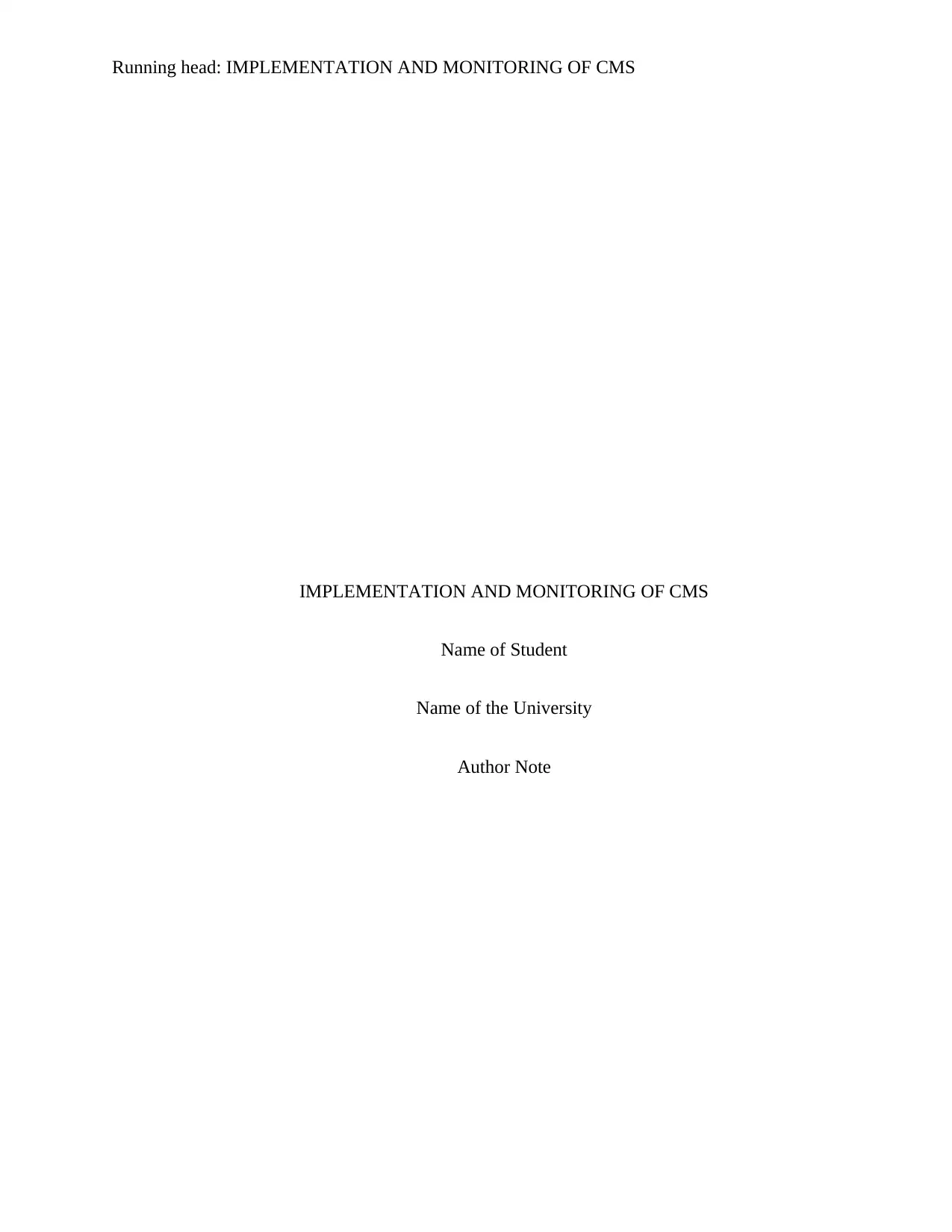
Running head: IMPLEMENTATION AND MONITORING OF CMS
IMPLEMENTATION AND MONITORING OF CMS
Name of Student
Name of the University
Author Note
IMPLEMENTATION AND MONITORING OF CMS
Name of Student
Name of the University
Author Note
Paraphrase This Document
Need a fresh take? Get an instant paraphrase of this document with our AI Paraphraser
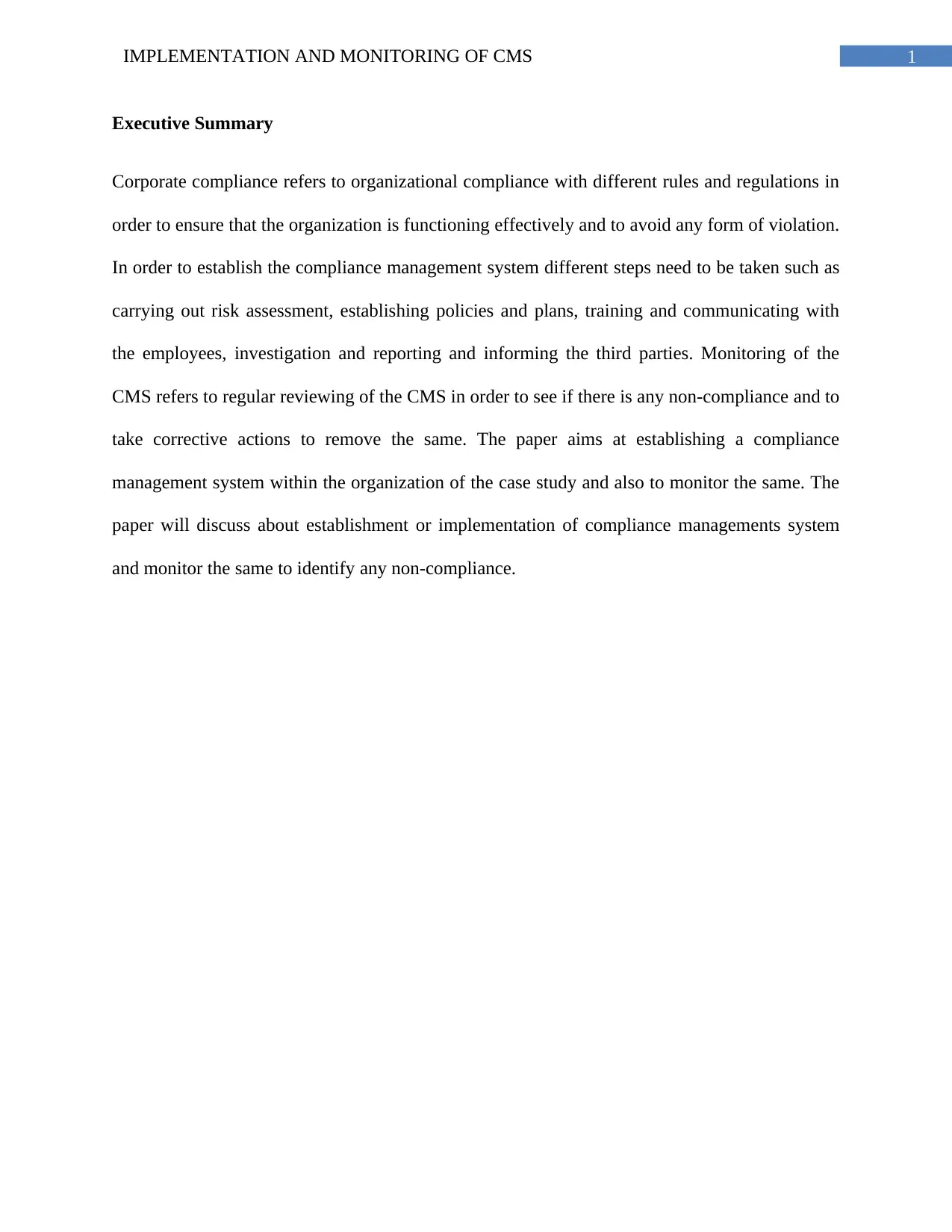
1IMPLEMENTATION AND MONITORING OF CMS
Executive Summary
Corporate compliance refers to organizational compliance with different rules and regulations in
order to ensure that the organization is functioning effectively and to avoid any form of violation.
In order to establish the compliance management system different steps need to be taken such as
carrying out risk assessment, establishing policies and plans, training and communicating with
the employees, investigation and reporting and informing the third parties. Monitoring of the
CMS refers to regular reviewing of the CMS in order to see if there is any non-compliance and to
take corrective actions to remove the same. The paper aims at establishing a compliance
management system within the organization of the case study and also to monitor the same. The
paper will discuss about establishment or implementation of compliance managements system
and monitor the same to identify any non-compliance.
Executive Summary
Corporate compliance refers to organizational compliance with different rules and regulations in
order to ensure that the organization is functioning effectively and to avoid any form of violation.
In order to establish the compliance management system different steps need to be taken such as
carrying out risk assessment, establishing policies and plans, training and communicating with
the employees, investigation and reporting and informing the third parties. Monitoring of the
CMS refers to regular reviewing of the CMS in order to see if there is any non-compliance and to
take corrective actions to remove the same. The paper aims at establishing a compliance
management system within the organization of the case study and also to monitor the same. The
paper will discuss about establishment or implementation of compliance managements system
and monitor the same to identify any non-compliance.
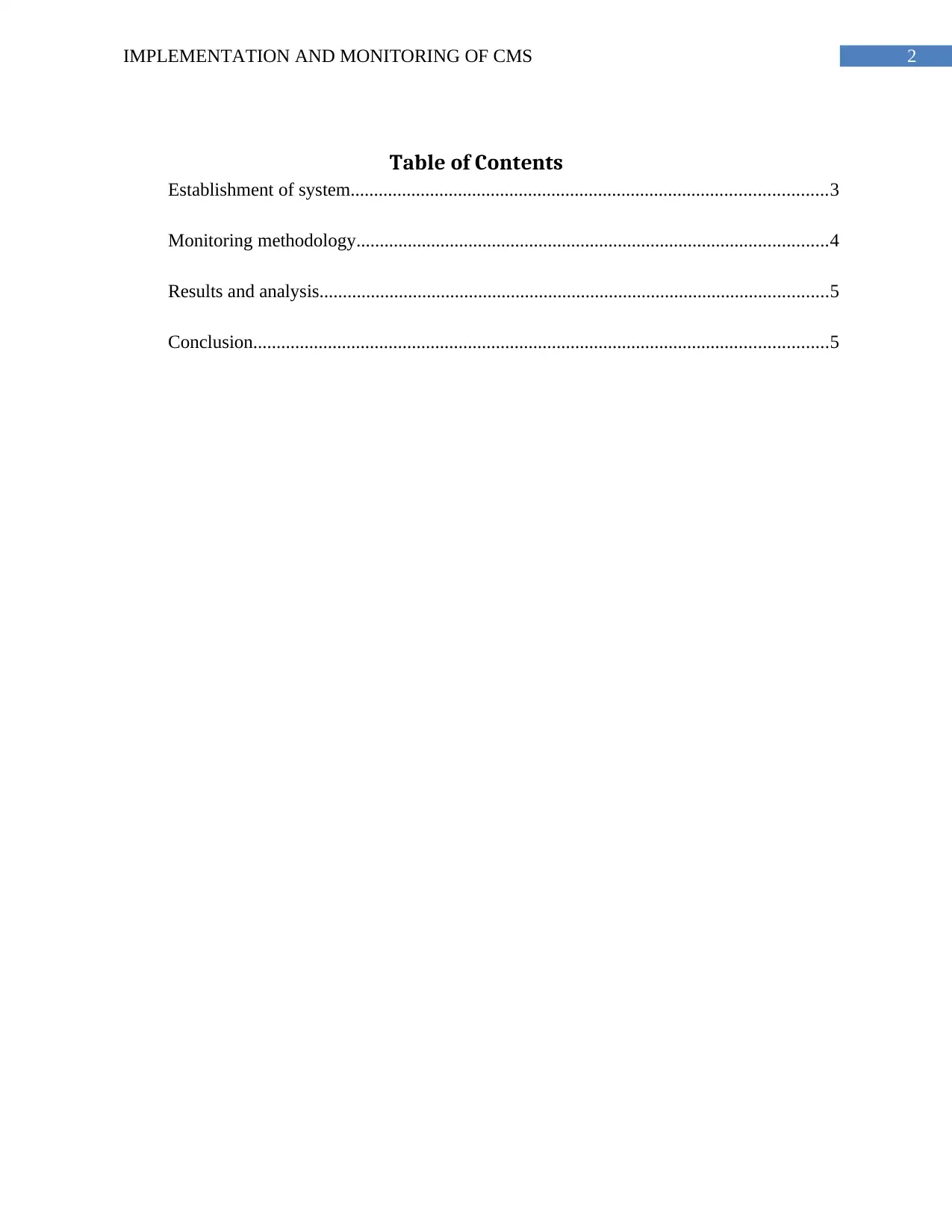
2IMPLEMENTATION AND MONITORING OF CMS
Table of Contents
Establishment of system......................................................................................................3
Monitoring methodology.....................................................................................................4
Results and analysis.............................................................................................................5
Conclusion...........................................................................................................................5
Table of Contents
Establishment of system......................................................................................................3
Monitoring methodology.....................................................................................................4
Results and analysis.............................................................................................................5
Conclusion...........................................................................................................................5
⊘ This is a preview!⊘
Do you want full access?
Subscribe today to unlock all pages.

Trusted by 1+ million students worldwide
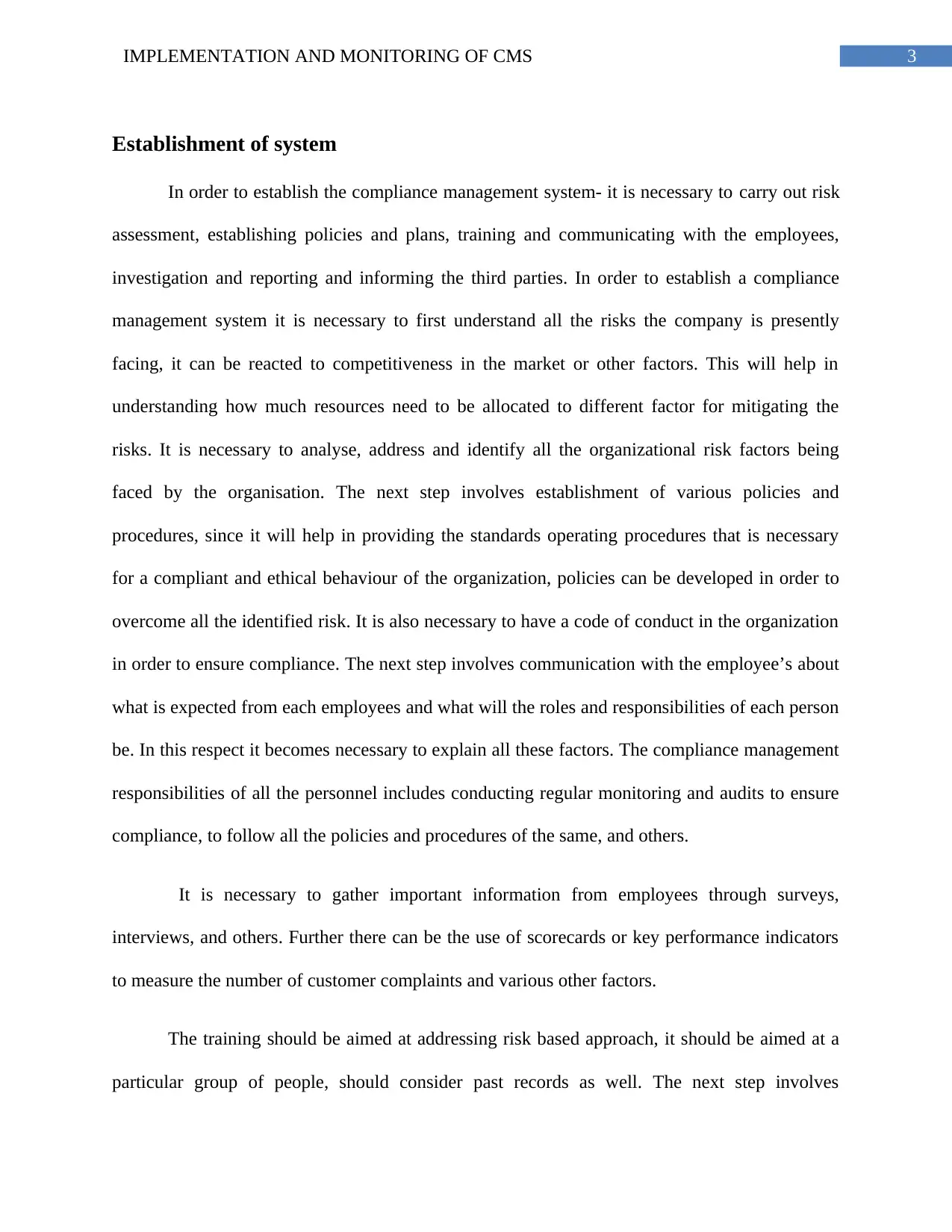
3IMPLEMENTATION AND MONITORING OF CMS
Establishment of system
In order to establish the compliance management system- it is necessary to carry out risk
assessment, establishing policies and plans, training and communicating with the employees,
investigation and reporting and informing the third parties. In order to establish a compliance
management system it is necessary to first understand all the risks the company is presently
facing, it can be reacted to competitiveness in the market or other factors. This will help in
understanding how much resources need to be allocated to different factor for mitigating the
risks. It is necessary to analyse, address and identify all the organizational risk factors being
faced by the organisation. The next step involves establishment of various policies and
procedures, since it will help in providing the standards operating procedures that is necessary
for a compliant and ethical behaviour of the organization, policies can be developed in order to
overcome all the identified risk. It is also necessary to have a code of conduct in the organization
in order to ensure compliance. The next step involves communication with the employee’s about
what is expected from each employees and what will the roles and responsibilities of each person
be. In this respect it becomes necessary to explain all these factors. The compliance management
responsibilities of all the personnel includes conducting regular monitoring and audits to ensure
compliance, to follow all the policies and procedures of the same, and others.
It is necessary to gather important information from employees through surveys,
interviews, and others. Further there can be the use of scorecards or key performance indicators
to measure the number of customer complaints and various other factors.
The training should be aimed at addressing risk based approach, it should be aimed at a
particular group of people, should consider past records as well. The next step involves
Establishment of system
In order to establish the compliance management system- it is necessary to carry out risk
assessment, establishing policies and plans, training and communicating with the employees,
investigation and reporting and informing the third parties. In order to establish a compliance
management system it is necessary to first understand all the risks the company is presently
facing, it can be reacted to competitiveness in the market or other factors. This will help in
understanding how much resources need to be allocated to different factor for mitigating the
risks. It is necessary to analyse, address and identify all the organizational risk factors being
faced by the organisation. The next step involves establishment of various policies and
procedures, since it will help in providing the standards operating procedures that is necessary
for a compliant and ethical behaviour of the organization, policies can be developed in order to
overcome all the identified risk. It is also necessary to have a code of conduct in the organization
in order to ensure compliance. The next step involves communication with the employee’s about
what is expected from each employees and what will the roles and responsibilities of each person
be. In this respect it becomes necessary to explain all these factors. The compliance management
responsibilities of all the personnel includes conducting regular monitoring and audits to ensure
compliance, to follow all the policies and procedures of the same, and others.
It is necessary to gather important information from employees through surveys,
interviews, and others. Further there can be the use of scorecards or key performance indicators
to measure the number of customer complaints and various other factors.
The training should be aimed at addressing risk based approach, it should be aimed at a
particular group of people, should consider past records as well. The next step involves
Paraphrase This Document
Need a fresh take? Get an instant paraphrase of this document with our AI Paraphraser
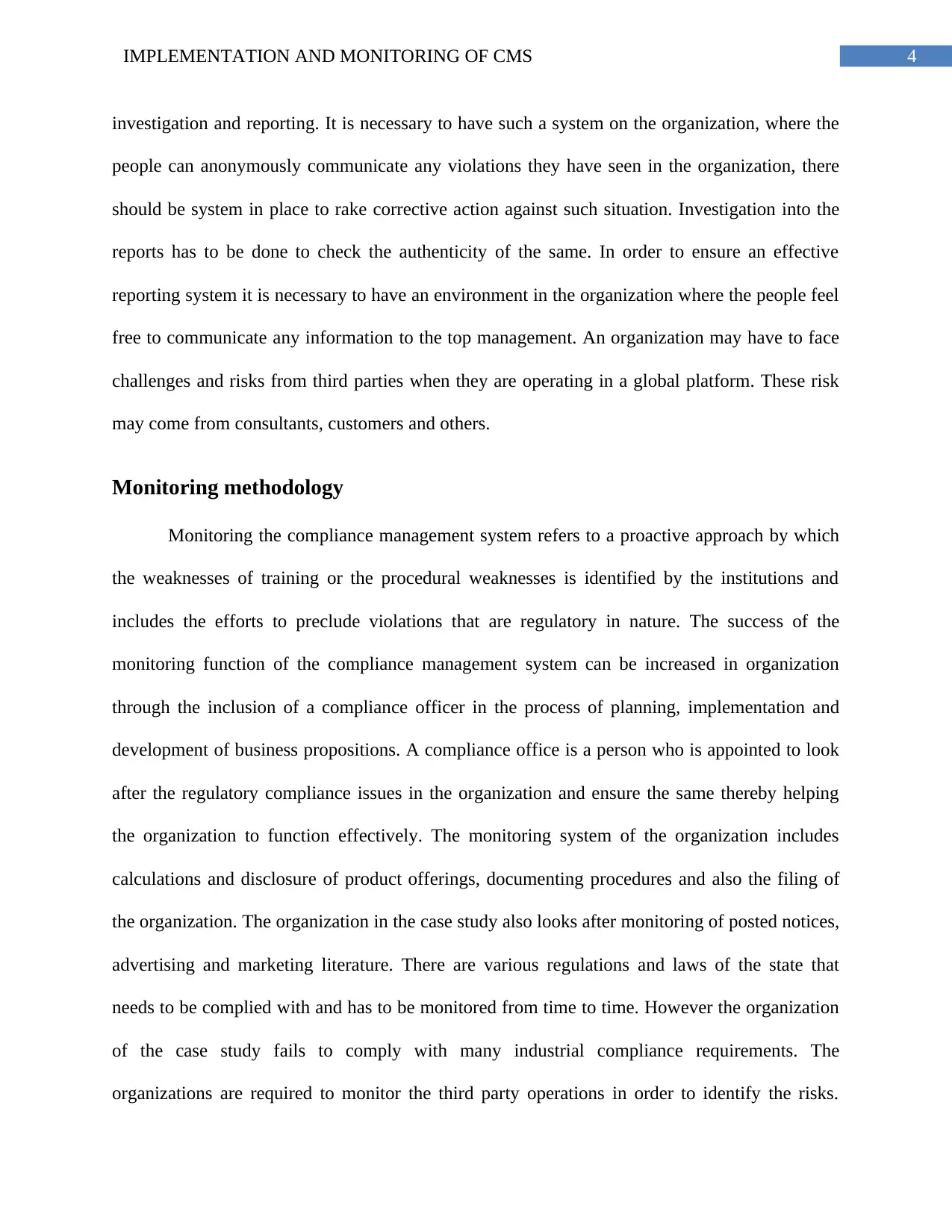
4IMPLEMENTATION AND MONITORING OF CMS
investigation and reporting. It is necessary to have such a system on the organization, where the
people can anonymously communicate any violations they have seen in the organization, there
should be system in place to rake corrective action against such situation. Investigation into the
reports has to be done to check the authenticity of the same. In order to ensure an effective
reporting system it is necessary to have an environment in the organization where the people feel
free to communicate any information to the top management. An organization may have to face
challenges and risks from third parties when they are operating in a global platform. These risk
may come from consultants, customers and others.
Monitoring methodology
Monitoring the compliance management system refers to a proactive approach by which
the weaknesses of training or the procedural weaknesses is identified by the institutions and
includes the efforts to preclude violations that are regulatory in nature. The success of the
monitoring function of the compliance management system can be increased in organization
through the inclusion of a compliance officer in the process of planning, implementation and
development of business propositions. A compliance office is a person who is appointed to look
after the regulatory compliance issues in the organization and ensure the same thereby helping
the organization to function effectively. The monitoring system of the organization includes
calculations and disclosure of product offerings, documenting procedures and also the filing of
the organization. The organization in the case study also looks after monitoring of posted notices,
advertising and marketing literature. There are various regulations and laws of the state that
needs to be complied with and has to be monitored from time to time. However the organization
of the case study fails to comply with many industrial compliance requirements. The
organizations are required to monitor the third party operations in order to identify the risks.
investigation and reporting. It is necessary to have such a system on the organization, where the
people can anonymously communicate any violations they have seen in the organization, there
should be system in place to rake corrective action against such situation. Investigation into the
reports has to be done to check the authenticity of the same. In order to ensure an effective
reporting system it is necessary to have an environment in the organization where the people feel
free to communicate any information to the top management. An organization may have to face
challenges and risks from third parties when they are operating in a global platform. These risk
may come from consultants, customers and others.
Monitoring methodology
Monitoring the compliance management system refers to a proactive approach by which
the weaknesses of training or the procedural weaknesses is identified by the institutions and
includes the efforts to preclude violations that are regulatory in nature. The success of the
monitoring function of the compliance management system can be increased in organization
through the inclusion of a compliance officer in the process of planning, implementation and
development of business propositions. A compliance office is a person who is appointed to look
after the regulatory compliance issues in the organization and ensure the same thereby helping
the organization to function effectively. The monitoring system of the organization includes
calculations and disclosure of product offerings, documenting procedures and also the filing of
the organization. The organization in the case study also looks after monitoring of posted notices,
advertising and marketing literature. There are various regulations and laws of the state that
needs to be complied with and has to be monitored from time to time. However the organization
of the case study fails to comply with many industrial compliance requirements. The
organizations are required to monitor the third party operations in order to identify the risks.
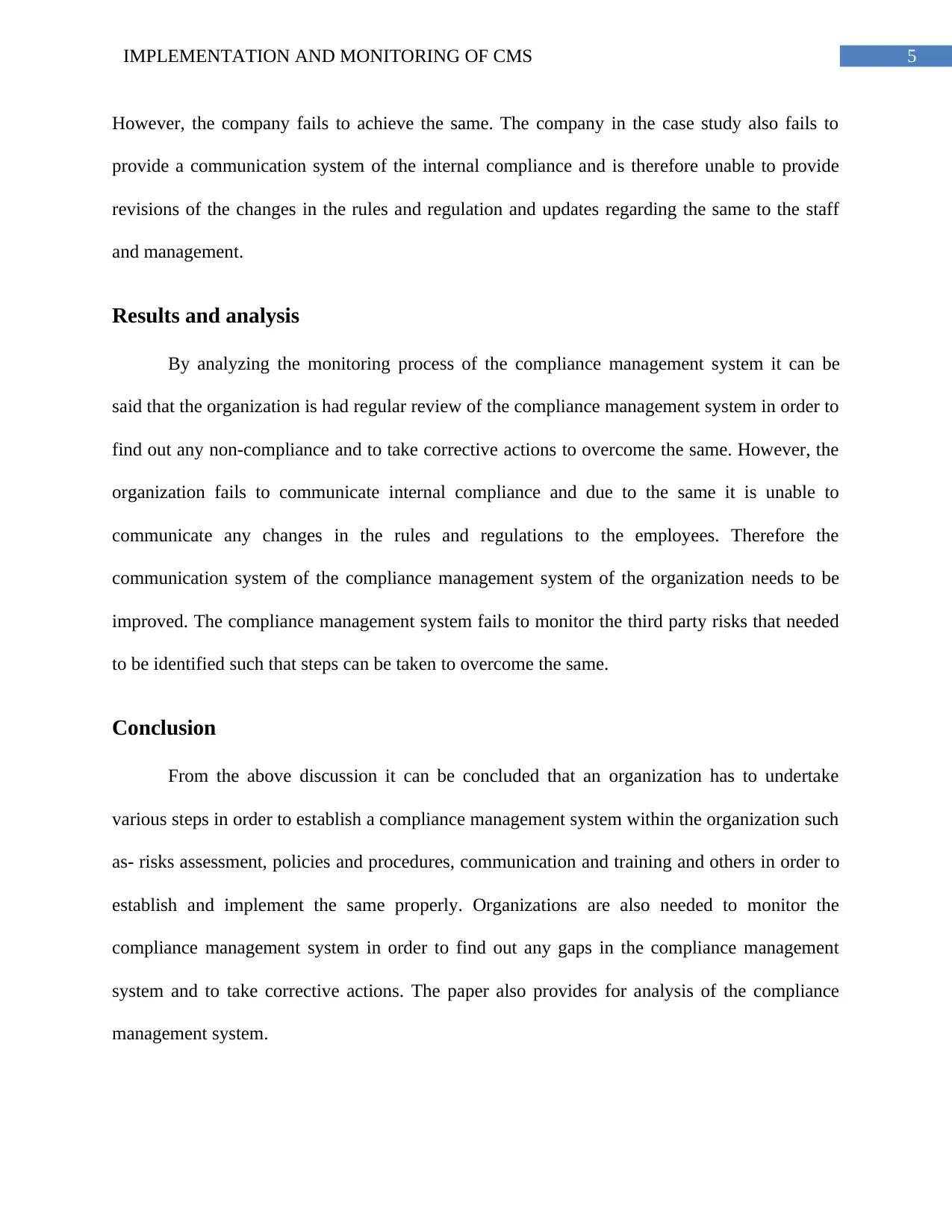
5IMPLEMENTATION AND MONITORING OF CMS
However, the company fails to achieve the same. The company in the case study also fails to
provide a communication system of the internal compliance and is therefore unable to provide
revisions of the changes in the rules and regulation and updates regarding the same to the staff
and management.
Results and analysis
By analyzing the monitoring process of the compliance management system it can be
said that the organization is had regular review of the compliance management system in order to
find out any non-compliance and to take corrective actions to overcome the same. However, the
organization fails to communicate internal compliance and due to the same it is unable to
communicate any changes in the rules and regulations to the employees. Therefore the
communication system of the compliance management system of the organization needs to be
improved. The compliance management system fails to monitor the third party risks that needed
to be identified such that steps can be taken to overcome the same.
Conclusion
From the above discussion it can be concluded that an organization has to undertake
various steps in order to establish a compliance management system within the organization such
as- risks assessment, policies and procedures, communication and training and others in order to
establish and implement the same properly. Organizations are also needed to monitor the
compliance management system in order to find out any gaps in the compliance management
system and to take corrective actions. The paper also provides for analysis of the compliance
management system.
However, the company fails to achieve the same. The company in the case study also fails to
provide a communication system of the internal compliance and is therefore unable to provide
revisions of the changes in the rules and regulation and updates regarding the same to the staff
and management.
Results and analysis
By analyzing the monitoring process of the compliance management system it can be
said that the organization is had regular review of the compliance management system in order to
find out any non-compliance and to take corrective actions to overcome the same. However, the
organization fails to communicate internal compliance and due to the same it is unable to
communicate any changes in the rules and regulations to the employees. Therefore the
communication system of the compliance management system of the organization needs to be
improved. The compliance management system fails to monitor the third party risks that needed
to be identified such that steps can be taken to overcome the same.
Conclusion
From the above discussion it can be concluded that an organization has to undertake
various steps in order to establish a compliance management system within the organization such
as- risks assessment, policies and procedures, communication and training and others in order to
establish and implement the same properly. Organizations are also needed to monitor the
compliance management system in order to find out any gaps in the compliance management
system and to take corrective actions. The paper also provides for analysis of the compliance
management system.
⊘ This is a preview!⊘
Do you want full access?
Subscribe today to unlock all pages.

Trusted by 1+ million students worldwide
1 out of 6
Related Documents
Your All-in-One AI-Powered Toolkit for Academic Success.
+13062052269
info@desklib.com
Available 24*7 on WhatsApp / Email
![[object Object]](/_next/static/media/star-bottom.7253800d.svg)
Unlock your academic potential
Copyright © 2020–2025 A2Z Services. All Rights Reserved. Developed and managed by ZUCOL.





